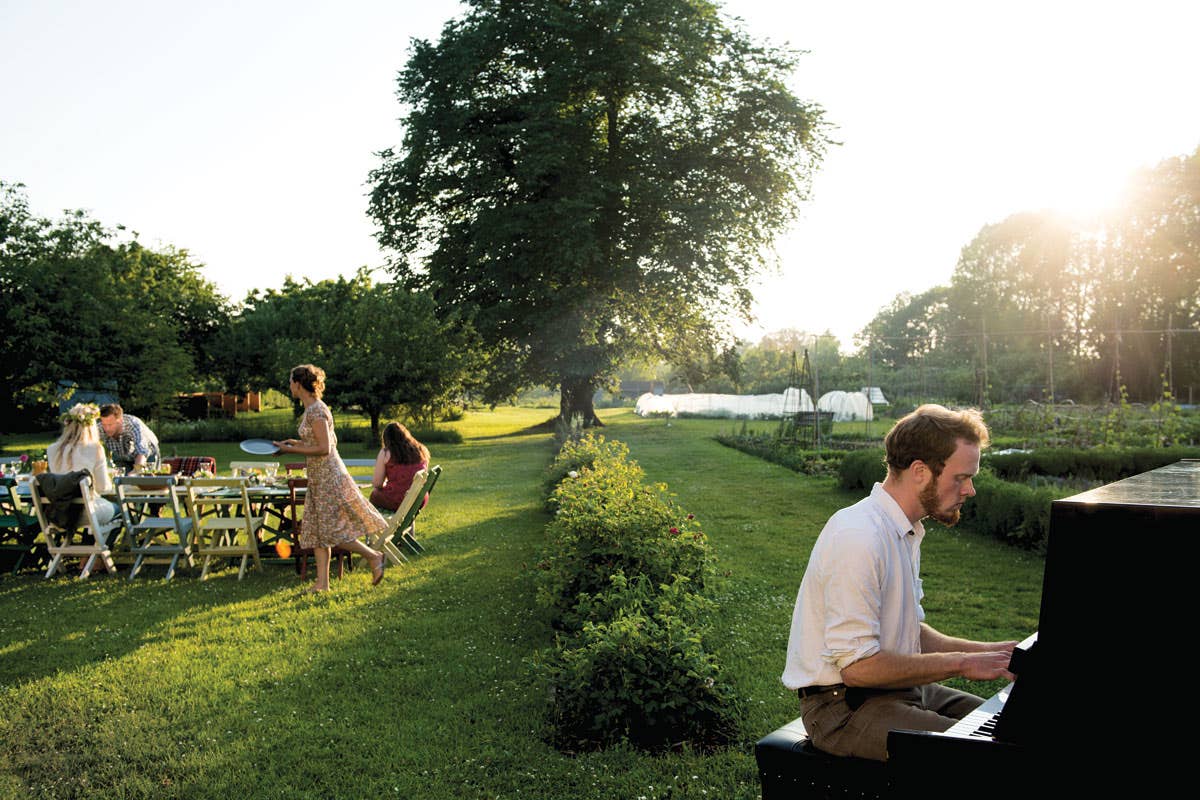
The soil on the Swedish island of Oland, off the mainland's southeastern coast in the Baltic Sea, has special powers. So says my gardener friend Asa Johanson, who lives here. “Anything you plant just explodes!” she exclaims, holding up an intensely green and purple kohlrabi that looks like a starburst, its root boasting a crown of thick leaves that radiate in all directions. It's an early June morning, and we are gathering vegetables for a lunchtime feast to commemorate Midsummer, a national holiday as important to us Swedes as Independence Day is to Americans, though its roots go much further back.
While Midsummer was traditionally celebrated on the summer solstice, it now takes place anywhere between June 20 and June 25. As far as traditions go, ambition levels vary. Some Swedes just head to a bar, attend a car race with hotted-up Volvos, or grab a few six-packs and a patch of grass to gather with friends. Others host extravagant parties featuring regional folk dresses, vast smorgasbords, and live music that go on for days.
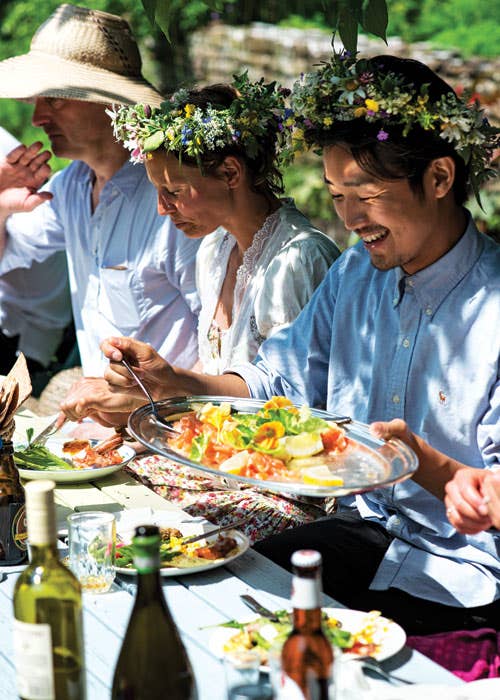
For this year's Midsummer celebration, I made the five-hour drive from Stockholm to Oland with a friend, Anna Olsson, to meet up with Asa, who's working as a gardener at Capellagården, a crafts school in the island's village of Vickleby. Friends of Asa's from the island will join us too, forming a group of a dozen or so revelers. The school, a renovated farmhouse that usually sits empty for several weeks over the summer, will be the site of our party.
By the time Asa and I return from the garden, it's eight in the morning. The sun has been up for five hours, and our friends are convening in the farmhouse's spacious kitchen. Though it's early, we are all excited and ready to cook. Asa and I put our haul on the counter: bouquets of fresh mint, sage, thyme, marjoram and basil, fennel, and a half-dozen duck eggs, their colors ranging from warm brown to bone white.
Anna, who has the curious distinction of being both a naval officer and a pastry chef, fires up a gas stove to boil a battalion's worth of new potatoes with sprigs of dill, while Nina Stenby, a textile artist who, along with her husband, Pelle Lundberg, runs a bed and breakfast in the village, prepares a traditional golden-colored Västerbotten cheese pie. As she pulls it from the oven, its steaming cream-and-egg-enriched filling framed by a browned, buttery crust, the kitchen is filled with a bewitching, nutty aroma. Meanwhile, Pelle, in deference to the vegetarians in our midst, does up a lively lentil salad tossed with cherry tomatoes he's sautéed in butter and olive oil with shallots, rosemary, and thyme until they nearly burst. Pelle has already stoked the school's woodburning pizza oven to make a rough country bread. And while Anna tackles the duck eggs, boiling, chopping, and drenching them in browned butter, Asa focuses on her produce, composing an enormous salad of lettuce, raw asparagus, and sunflower seeds that she decorates with flowers before dressing it with olive oil and pepper.
As everyone else is occupied with the cooking, I decide to make some aquavit, Sweden's most beloved libation. I pour vodka into bottles packed with aromatics—lemon verbena, dill, fennel, and lemon peel—and place them in the refrigerator to chill. I know that in a few days the spirit will be wonderfully infused with their flavors.
Since it is virtually unthinkable to undertake a traditional Midsummer feast without fish—the bedrock of Swedish cuisine—we have plates and plates of it. There is gravadlax, salmon cured with salt, sugar, white pepper, and dill, which Pelle skillfully cuts into long translucent ribbons. We also have smoked flounder and innumerable variations on pickled herring, some matured for months with cinnamon, allspice, sandalwood, and sugar, others quick-pickled in white vinegar, sugar, and salt. Looking over our spread, I am reminded of something British food critic A.A. Gill once wrote: "If you think Swedish women are spectacular, wait till you see the fish!"
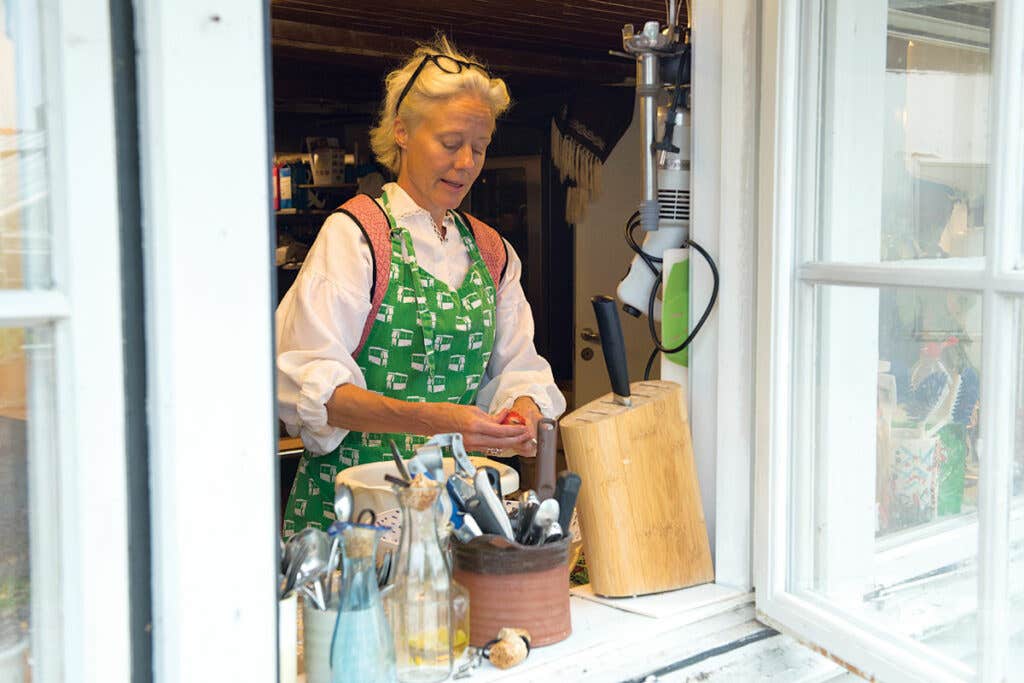
At 11 a.m. we start setting the huge communal table, which we've assembled from several slightly warped and tarnished folding garden stands and have arranged under a great ailanthus tree in the field behind the farmhouse. But no sooner do we get the first place setting down than the sky suddenly darkens and it starts to rain. There's thunder in the distance, so we scurry to move the feast indoors. Soon we're set up in the sedate dining room at Capellagården. But as we start to bring the food out from the kitchen, the sky clears up. And so we move back outside, set our table, fill our glasses with aquavit, and toast the sun with a resounding “Skål!” (Cheers!)
Moments later plates are being passed at a pace that's almost comically frenetic. There are grilled lamb sausages from the village; buttercup yellow wedges of sharp Västerbotten cheese; pillowy slices of the fantastic filmjölkslimpa, a rustic whole wheat bread that's dense with nuts and seeds made by Pelle this morning, now spread with fresh sweet butter. And, of course, there's a basket of knäckebröd, rye crispbreads with an addictive crunch. I take great pleasure in piling my plate high with spiced pickled herring drenched in a sweet and sour brine loaded with fresh chopped chives and red onions. It's my favorite thing on the table, though it faces stiff competition from the mustard herring and horseradish herring, both of which I mound atop the crispbreads. Pelle soon proposes a toast, and instinctively everyone tunes up to sing:
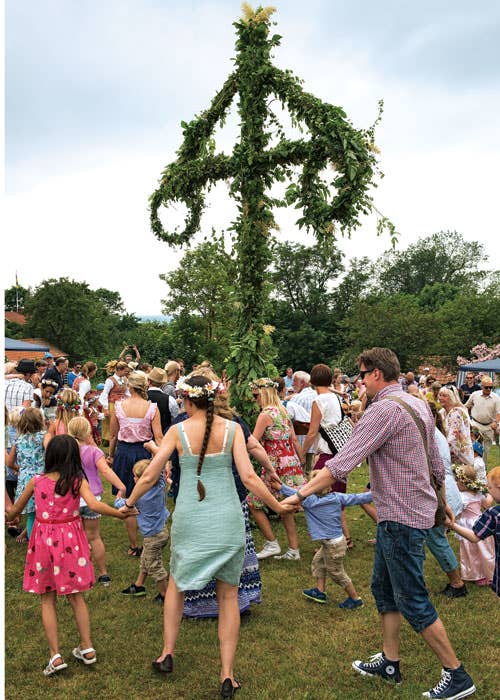
Helan går
Sjung hopp faderallan lallan lej
Helan går
Sjung hopp faderallan lej
Och den som inte helan tar
Han heller inte halvan får
Helan går!
Sjung hopp faderallan lej
Here's the first
Sing hop fol-de-rol lalen ley
Here's the first
Sing hop fol-de-rol lalen ley
He who doesn't drink the first
Shall never, ever quench his thirst
Here's the first
Sing hop fol-de-rol lalen ley
It's the most popular drinking song in the country. At the penultimate verse, everybody raises a glass, makes eye contact with as many people as possible, downs his or her drink, and pours another round while continuing to sing. Between gulps and verses, I savor the combination of the buttery duck eggs with the silky gravadlax, the creamy cheese pie, and the zesty herb-packed salads. I chase down the herrings and salmon with shots of both the herbaceous citron-laced aquavit and a drink made from sloe berries picked by Asa and her mother last fall in this very spot. I steeped those berries in vodka for three months in my pantry back in Stockholm, and now their plumlike flavor and dark red color suffuses the drink.
Though it feels as if we could eat all afternoon, at 3 p.m. we take a break to clear the table and head into town to participate in another time-honored Midsummer activity, which takes place on a grassy field. Here we join a few hundred other merrymakers for the raising of the majstång, a tall pole festooned with greenery and flowers. Armed with a picnic basket filled with coffee and pastries, I watch as children dance and play games around the pole, helping myself to creamy spoonfuls of Asa's cheesecake topped with mint, strawberries, and clouds of whipped cream.
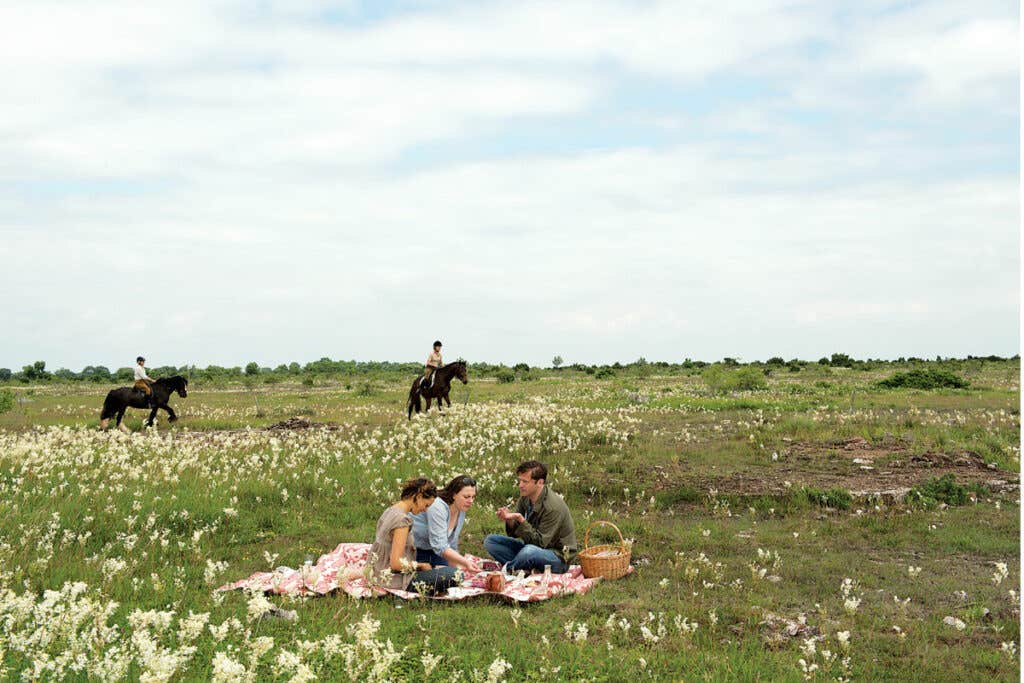
Part of the pleasure of Midsummer is the seemingly endless hours of sunlight, which afford us ample time for yet a second epic meal. While lunch was a traditional smorgasbord of classic Swedish dishes, dinner is a far more casual affair. Back at the farmhouse, we head outside and fire up a woodburning grill.
As we place logs onto the fire, we are surprised to hear the sounds of men laughing and shouting in the distance. Suddenly Pelle and some of his friends come around the corner of the house struggling to move a stand-up piano on a pushcart, wobbling considerably on the uneven terrain. “Let's put it on the lawn!” Pelle says excitedly, waving his arms to direct his crew. After some loud discussion and heavy lifting, the piano is in place, a green herb garden providing a perfect backdrop.
Swedish Potato Dumplings Stuffed with Bacon and Onion (Kroppkakor)
Kroppkakor, hearty mashed potato dumplings stuffed with an allspice-laden filling of bacon and onion, are a specialty of Oland, an island off the southern coast of Sweden. Get the recipe for Swedish Potato Dumplings »
Some of us gather around the piano as Pelle's friend Chester Elmroth starts playing a series of jazzy standards. Others huddle by the glowing coals of the grill, lured by the scent of roasting lamb blanketed in fresh herbs, pork sausages, and the makings of a grilled salad: asparagus, kohlrabi stems, and quartered eggplants, all slathered in olive oil. Once they come off the grill, we toss them with boiled buttered beets and lemon-juice-soaked fennel.
Again we set the table, taking our time, as there are still many hours of daylight (and, we hope, clear skies) left. Finally, the meats come off the grill, and we sit down to clink glasses once more. The lamb is juicy and tender, with a crust of caramelized herbs, and the grilled salad is wonderfully warm and smoky. An ad-hoc composition of leftovers from the luncheon is a welcome dish, with its mash-up of new potatoes, dill, and chopped, blanched kohlrabi, all bathed in melted butter. When I start to flag, I seek the snap of fresh vegetables; the mizuna and radishes Asa and I harvested this morning make up a pleasingly bitter salad that reawakens my appetite. After a while, the table disperses, and a few of us climb up on the roof of Capellagården to finish dinner while watching the sun go down over Sweden, munching on local cheese, homemade hard bread, and nuts and drinking wine until long after the sun has set.
That sun is high in the sky by the time I roll out of bed the next morning, my head as foggy as one would expect after such a day of revelry. Still, there are things to do today, things I am determined not to miss. Just a short walk from Vickleby is a vast limestone plain known as the Great Alvaret. I convince my friends to head there; it's the perfect place to recuperate.
We arrive just before noon to find a serene landscape of grass, flowers, and low bushes waving slowly in the wind. It's painfully beautiful and—considering our collective condition—mercifully quiet, apart from the calming birdsong. We're lucky, too. We've come here on one of the few days when you can witness the short flowering of dropwort, which coats the plains in milky white.
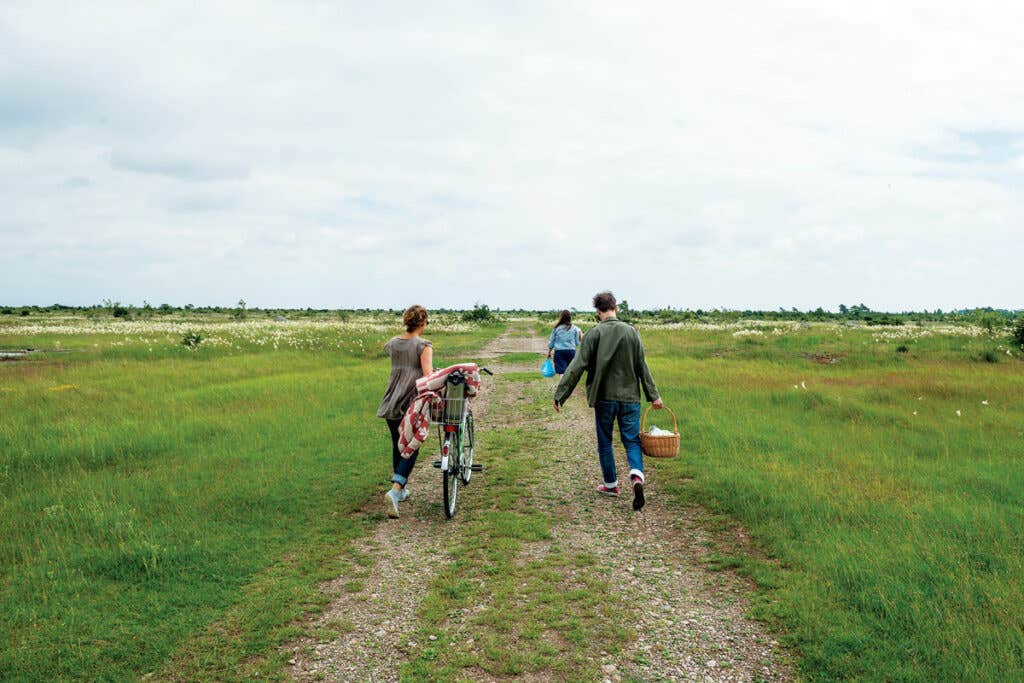
Asa, Anna, Nina, and I have brought along the perfect Oland picnic brunch: kroppkakor, a local specialty of fortifying dumplings made with potato, flour, bacon, onion, and spices. We enjoy them in the customary way, with sour cream, to boost the richness, and lingonberries, which provide refreshing acidity and sweetness. Pelle suddenly turns up on his Brompton folding bicycle, eager to get his share of kroppkakor, too. Maria, a friend of Asa's who lives nearby, arrives with two horses, offering us all a chance to go riding on her young Irish Tinker horse.
I decide to stay put, stretching out on a blanket for a much-needed afternoon nap. Far in the distance I can see a line of cows moving slowly along the horizon. As my eyelids begin to droop, I try not to think about the long drive back to Stockholm or the steadily shortening days that lie ahead. Instead I savor the sense of ease and contentment I feel—the feeling of Midsummer.
Keep Reading
Continue to Next Story










